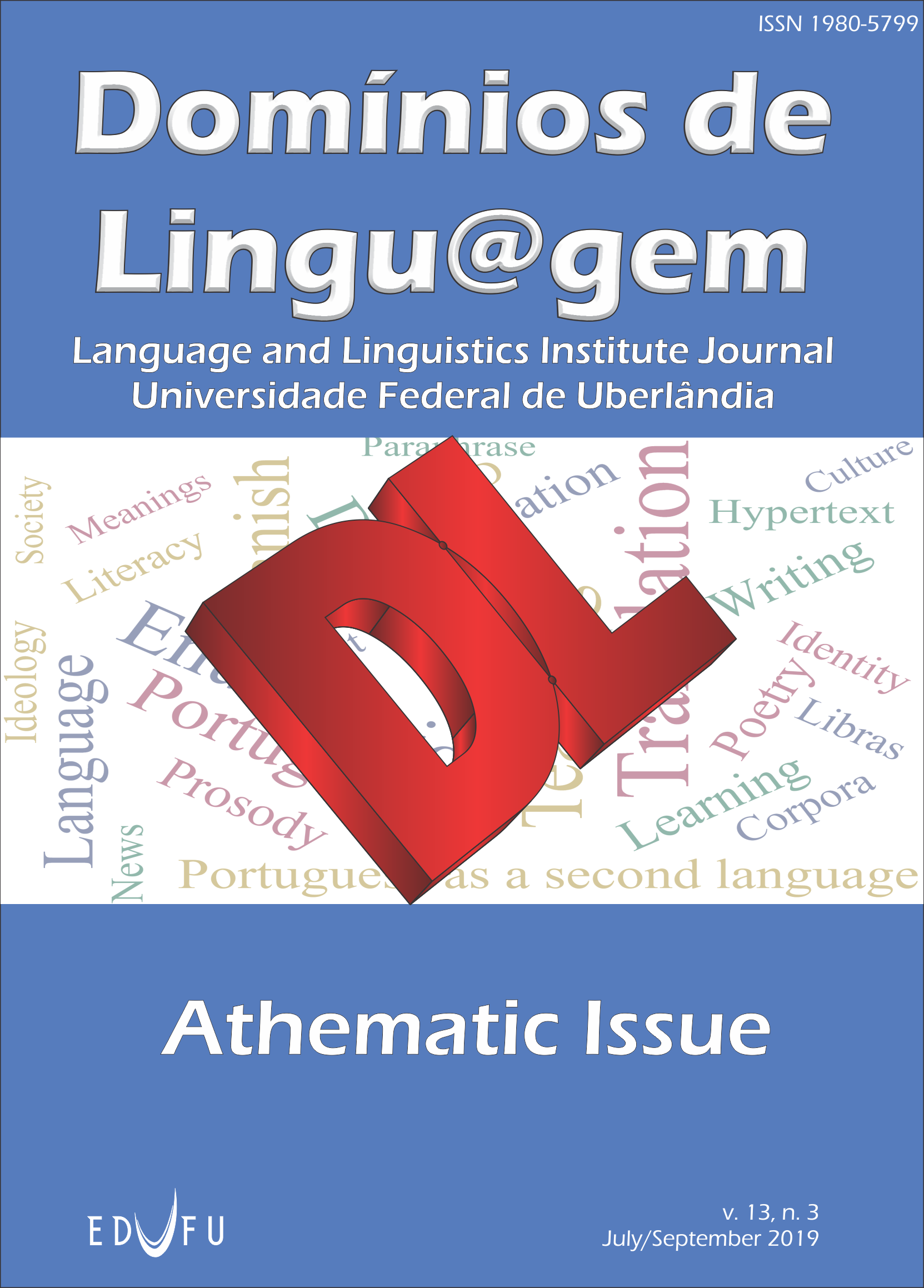The importance of linguistic documentation and description for revitalization of endangered languages
DOI:
https://doi.org/10.14393/DL39-v13n3a2019-4Keywords:
Documentation, Descriptions, Revizalization, Indigenous LanguagesAbstract
Researches projects aiming at documenting and describing endangered languages are extremely important for their revitalization. In addition, to promoting scientific knowledge, such studies also benefit the linguistic communities, by contributing to strengthen their languages and cultures. This paper offers a brief reflection on the importance of language description and documentation for the revitalization of languages threatened by extinction, focusing on efforts aimed at the promotion and revitalization of Apurinã, an Aruák language spoken in the southwest of the Brazilian state of Amazonas. The paper then discusses such examples as they relate to the general issue of promoting the strengthening of Brazil's indigenous lan-guages and cultures.
Downloads
Metrics
References
AIKHENVALD, A. Y. Arawak. In: STRAZNY, P. (ed.). Encyclopedia of Linguistics. New York: Fitzroy Dearborn, 2005. p. 81-84.
AUSTIN, P. K. Current issues in languages documentation. In: AUSTIN, P. K. (ed.). Language Documentation and Descripition. v. 7. Londres: SOS, 2010. p. 12-33.
AUSTIN, P. K.; SALLABANK, J. Language endangerment. Cambridge University Press, New York, 2011. 581 p.
CORRÊA, G. G. As reformas educacionais brasileiras: programas de ensino em Ciências e seriação escolar. 1997. 201 f. Dissertação (Mestrado em Educação) - Centro de Ciências Humanas e Artes, Universidade Federal de Uberlândia, Uberlândia, 1997. DOI https://doi.org/10.5327/z2176-947820160027.
CUNHA, R. B. Políticas de línguas e educação escolar no Brasil. Educar, n. 32, Curitiba, p. 142-159, 2008. DOI https://doi.org/10.1590/s0104-40602008000200011.
DALBY, A. Language in Danger: The Loss of Linguistic Diversity and the Threat to our Future. New York, Columbia University Press. 2003. In: DRUDE, S. Documentação Linguística: o formato de anotações de textos. Estudos Linguísticos, XXXV, p. 27-51, 2006.
DRUDE, S. Documentação Linguística: o formato de anotações de textos. Estudos Linguísticos, XXXV, p. 27-51, 2006.
FACUNDES, S. da S. The Apurinã (Arawak) Language of Brazil. SUNY-Buffalo: Tese de Doutorado, 2000, p. 702.
FACUNDES, S. da S.; VIRTANEN, P. K.; FREITAS, M. F. P. de; LIMA-PADOVANI, B. F. S. de; COSTA, P. N. Issues on language revitalization and engagements in the Amazon: The case of Apurinã. In: BRUNN, S. D.; KEHREIN, R. Handbook of the Changing World Language Map. Melbourne: Springer Nature, 2018. DOI https://doi.org/10.1007/978-3-319-73400-2_35-1.
HIMMELMANN, N. P. Language Documentation: What is it and what is it good for? In: GIPPERT, J.; HIMMELMAN, N.; MOSEL, U. (org.). Essentials of Languages Documentation. Berlin: Mouton de Gruyter, 2006. 437 p.
HIMMELMANN, N. P. Documentary and descriptive linguistics. Linguistics, Ruhr-Universität Bochum, v. 36, p. 95-161, 1998. DOI https://doi.org/10.1515/ling.1998.36.1.161.
HINTON, L; HALE, K. The Green Book of Language Revitalization in Practice. Academic Press, 2001.
LADEIRA, M. E. De “povos grafos” a “cidadãos analfabetos”: as concepções teóricas subjacentes às propostas educacionais para os povos indígenas no Brasil. In: CUNHA, M. C.; CESARINO, P. N. (org.). Políticas culturais e povos indígenas. São Paulo: Unesp, 2016. DOI https://doi.org/10.5380/cra.v19i2.58555.
LIMA-PADOVANI, B. F. S. Levantamento Sociolinguístico do Léxico da Língua Apurinã e sua contribuição para o conhecimento da cultura e história Apurinã (Aruák). Dissertação (Mestrado) - Universidade Federal do Pará, Belém, 2016. f. 192. DOI https://doi.org/10.20873/uft.2179-3948.2019v10n1p161.
MOORE, D.; GABAS, N. J. O Futuro Das Línguas Indígenas Brasileiras. Saturno. DOI https://doi.org/10.28998/0103-6858.2000n25p13-29. Disponível em: http://saturno.museu-goeldi.br/lingmpeg/portal/downloads/publicacoes/denny-futudo-das-linguas-indigenas-brasileiras.pdf. Acesso: 25 abr. 2018.
MOORE, D.; GALUCIO, A. V.; MOORE; GABAS, N. J. Desafio de documentar e preservar línguas. Scientific American Brasil. v. 3, p. 36-43, 2008. Edição Especial.
MOORE, D.; GALUCIO, A. V. Perspectives for the documentation of indigenous language in Brazil. In: BÁEZ, G. P.; ROGERS, C.; LABRADA, J. E. R. (org.). Language Documentation and Revitalization in Latin American Contexts. 1 ed. Berlin: De Gruyter, v. 295, p. 29-58, 2016. DOI https://doi.org/10.1515/9783110428902.
MUFWENE, S. S. The Ecology of Language Evolution. Chicago: Cambridge University Press, University of Chicago, 2001. 274 p.
MÜHLHÄUSLER, P. Assessing the demage: structural and lexical effects. In: Linguistic Ecology: language change and linguistic imperialism in the Pacific region. London; New York: Routledge, 1996. p. 269-310. DOI https://doi.org/10.4324/9780203211281.
RODRIGUES, A. Línguas indígenas brasileiras. Brasília: Laboratório de Línguas Indígenas da UnB, 2013. p. 29. DOI https://doi.org/10.11606/d.18.2010.tde-22122010-154505. Disponível em: http://www.laliunb.com.br. Acesso em: 02 mar. 2018.
SCHIFFMAN, H. F. Linguistic culture and Language Policy. London; New York: Routledge, 1996.
SEKI, L. Perspectivas para os estudos linguísticos no Brasil. Boletim da ABRALIN, 12. Campinas: IEL/Unicamp, 1991. p. 7-24.
SEKI, L. A Linguística Indígena no Brasil. Delta, vol. 15, nº Especial, 1999. p. 257-290.
SEKI, L. A linguística Indígena do Brasil. Delta, vol. 15, n. 5, 2009. p. 257-290.
SILVA, W. de L. Apresentação: estudos linguísticos de línguas indígenas brasileiras. ReVEL, 2009. p. 1-8.
SPOLSKY, B. Language Policy. Cambridge: Cambridge University Press, 2004.
WOODBURY, A. C. Language Documentation. In: AUSTIN, P. K.; SALLABANK, J. (org.). Language documentation and archiving. New York: Cambridge University Press, 2011. p. 159-186. DOI https://doi.org/10.1017/cbo9780511975981.009.
Downloads
Published
How to Cite
Issue
Section
License
Authors who publish in this journal agree to the following terms:
Authors retain the copyright and waiver the journal the right of first publication, with the work simultaneously licensed under the Creative Commons Attribution License (CC BY-NC-ND 4.0), allowing the sharing of work with authorship recognition and preventing its commercial use.
Authors are authorized to take additional contracts separately, for non-exclusive distribution of the version of the work published in this journal (publish in institutional repository or as a book chapter), with acknowledgment of authorship and initial publication in this journal.









